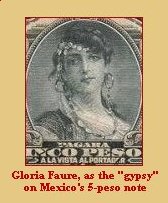 One of the interesting sidelights of cataloging books and auction catalogs is the "backstory" of the folks "behind the book" so to speak. This can be especially true of auction catalogs. How do I get from an illustration of the famous "gypsy" on Mexico's 5-peso note to a 1942 auction of Old Masters and Italian Primitives?
One of the interesting sidelights of cataloging books and auction catalogs is the "backstory" of the folks "behind the book" so to speak. This can be especially true of auction catalogs. How do I get from an illustration of the famous "gypsy" on Mexico's 5-peso note to a 1942 auction of Old Masters and Italian Primitives? Child's play.
You see, we recently had a copy of the auction catalog for a collection of 37 paintings sold in 1942 by a collector named Alberto J. Pani, who was an interesting man...
Alberto J. Pani was an important and colorful figure in Mexican history. He served as Finance Minister, and also was responsible, with architect Federico Mariscal, for completing the fabulous 'Palace of Fine Arts', a building which had originally been conceived as a national theater. Pani and Mariscal came up with the concept of making it a multi-use civic building for all the arts, a new idea at the time which has today become commonplace.
Pani was also a friend of artist Diego Rivera, and when Pani was the Mexican Minister to France he was instrumental in urging Rivera, who had been living in Paris and Italy, to return to Mexico.
Pani made headlines in other ways as well. He was what was politely known as a "ladies' man", and one of his mistresses was the well-known Catalan dancer Gloria Faure, whose image became immortalized when her portrait was used (anonymously) for Mexico's 5-peso banknotes from 1925-1972. Pani took Faure with him to New York in 1925 while negotiating a financial deal on behalf of the Mexican government. While there he was accused of "white slavery" under the Mann Act and his hotel room was searched. Although no formal charges were brought, an international scandal erupted, and Pani offered to resign. Mexican President Calles refused the offer, and is said to have commented at the time that he "did not want a Cabinet of eunuchs".
Oh, and the auction? The 37 Old Masters and Italian Primitives show that Pani had good taste in art as well...

No comments:
Post a Comment